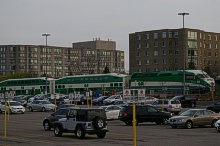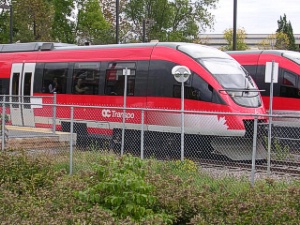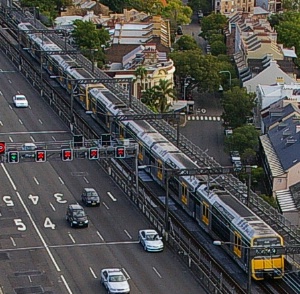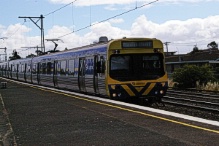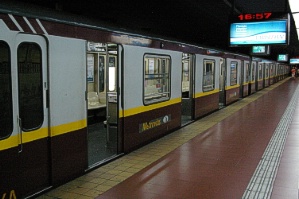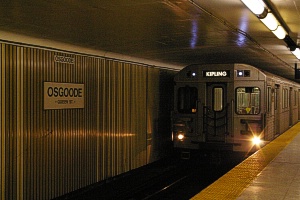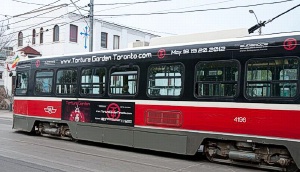This page was last updated May 1, 2012
Send questions and comments here.
Comparing
Light Rail and
Other Rapid Transit
Terms
With talk about "extending the Yonge subway", "building dedicated bus lanes", or "implementing LRT", it is important to understand what the different terms mean.
Most residents of the GTHA would have a pretty good idea of what one was speaking of when using the term "subway". However, some would argue that anything placed in a tunnel is subway, whether it is a tunnel for streetcar-type vehicles, full railway trains, metro trains, or even buses. One misconception of this is that the construction of such a tunnel is the sole expense involved in the project. While the tunnel is a major cost, some of these modes of transit cost less to build underground than some of their counterparts.
To start off, on this page the term subway will be avoided and the following terms will be used:
Bus Rapid Transit (BRT)
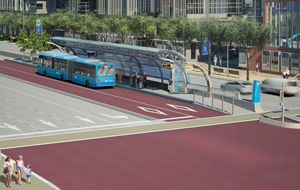
Operation of buses mostly on a dedicated or median right of way with stations or stops placed at wider intervals than regular bus operation. In some cases, vehicles may operate on a route that is only partly in isolated and partly in regular mixed-traffic operation.
Examples:
- VIVA's rapidways in York Region
- busway operations by OC Transpo in Ottawa
- Port Authority busways in Pittsburgh
Commuter Rail
Commuter Rail typically consists of a locomotive pulling passenger cars on existing railways, operating at high speeds with gentle starts and stops. Routes are typically 40-80 km long with a terminal in a central business district. Service is generally geared toward morning and evening commutes.
Examples:
- GO Transit rail operations in the GTHA
- West Coast Express in Vancouver
- Trinity Rail Express in Dallas and Fort Worth, Texas
Diesel Multiple Unit (DMU)
Railway passenger vehicles powered by built-in diesel engines. DMUs can provide similar capacity to LRT without the need for electrification. Electrification adds a cost that is economical for lines needing a high frequent service. Thus, DMUs are usually a better choice for relatively light traffic situations where railway infrastructure is available where the transit need exists.
Example:
- OC Transpo's O-Train operations in Ottawa
Electric Multiple Unit (EMU)
Railway passenger vehicles powered electriclly by overhead (and sometimes third rail) power using railway infrastructure. EMUs can provide service levels similar to HRT/Metro using existing railway infrastructure.
Example:
- CityRail in Sydney Australia
- Metropolitian Trains in Melbourne Australia
Heaviy Rail Rapid Transit (HRT or Metro)
HRT refers to a rapid transit system using metro type vehicles operating on a track infrastructure that must be totally isolated from all road and pedestrian traffic with stations limiting the movement of passengers. Often powered from a third rail, some implementations of HRT use an overhead power source. The common use of third rail power means that HRT must use high level platforms. Service is intended primarily for central city travel, and stations tend to be closer together than commuter rail, bur further apart than surface alternatives. Heavy rail requires large rights-of-way when on the surface.
Included in this category are systems such as the Scarborough RT, Vancouver's SkyTrain, and London's Docklands Light Railway. Despite these systems having a light-to-intermediate capacity, their need for a totally isolated right of way plus a signalling and control system that supports automatic train control places them with HRT. Some refer to a system such as these examples as a Mini Metro.
Examples:
- TTC Subway
- London Underground
- Paris Metro
- Buenos Aires Subte
Light Rail Transit (LRT)
LRT refers to a higher-order transit system using vehicles not unlike streetcars operating on a track infrastructure that may or may not be totally isolated from the public. This means there can be at-grade crossings with traffic and pedestrians, and it may occasionally operate in mixed-traffic situations. A Light Rail Vehicle is usually controlled by an operator, though automated control systems are sometimes used for operation on an isolated right of way. A limited amount of interlocking and automatic signals, including standard traffic signals are used with LRT operations.
Light rail offers flexibility of location because it can be operated in a street as well as a dedicated right-of-way for rapid operation without interference from other traffic. It may move from one to the other as required.
Examples of this can be seen on this site through the LRT In Other Cities page.
The "Light" and the "Heavy"
The light and heavy words in LRT and HRT can be confusing. They tend to refer to passenger capacity.
Some confuse it with the rolling stock which is problematic as it is not unusual for an LRV to be heavier than a metro car. Since LRVs have the flexibility of operating in situations involving other vehicles (even on a separate right of way, there can be level crossings with LRT), they need to have protection from side collisions.
Some think in terms of the rail the vehicles run on, as LRT systems often use lighter grade rail. This is not always the case. Additionally, when it comes to heavier rail, that definition may blend HRT with Commuter Rail systems.
A Word About Streetcars
Streetcars are a subset of LRT, meaning that all streetcars are Light Rail Vehicles, but not all Light Rail Vehicles are streetcars. The distinction can be blurry because though streetcar operation tends to be restricted to on-street mixed with traffic, it sometimes uses median or separate right of ways. Similarly, a Light Rail implementation may involve mixed traffic running, particularly at end-of-line branches where service frequency is lower.
The other distinction is that streetcar operation tends to mimic regular bus operation in that stop locations are much closer together. A full LRT implementation tends to have longer stop distances, often a minimum of 300 metres.



